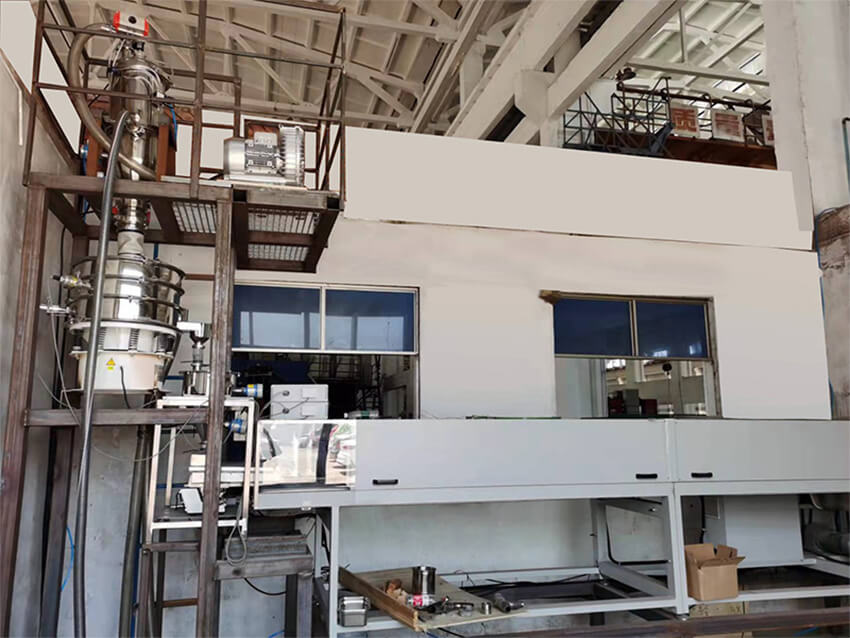
Positive electrode powder: usually black powder, loose, with a bulk density between 1100 and 1300 kg/m³ and a particle size of about 5 to 10 microns. The chemical properties of the positive electrode powder are stable, with no special odor, a mass content of ≥97.5%, and a metal content of ≤2.5%. The positive electrode powder is easily soluble in sulfuric acid, and the dry powder is hygroscopic.
Positive and negative electrode powder mixture: also black powder, loose, with a low bulk density of about 900 to 1150 kg/m³, and a particle size of about 5 to 10 microns. The positive electrode powder accounts for the majority of the mixture and is easily soluble in sulfuric acid; the negative electrode material graphite powder is insoluble in acid and alkali.
Graphite powder: As a negative electrode material, graphite powder is insoluble in acid and alkali, and is different from the positive electrode powder in physical and chemical properties.
Metals
Metallic aluminum: silvery white, granular, particle size between 0.1mm and 10mm, bulk density of about 250kg/m³ to 450kg/m³, easily soluble in acid and alkali.
Metallic copper and iron: also granular, particle size and bulk density are similar to those of metallic aluminum. Copper is insoluble in acid and alkali, while iron may react under certain conditions.
Diaphragm paper, plastic and aluminum-plastic film: these materials are usually a mixture of grayish white and blue, with a low bulk density of about 50 to 100kg/m³ in a loose state. These materials need to be comprehensively utilized as solid waste.
Anti-static and anti-agglomeration
Because the powder in lithium battery materials is fine in particle size, it is easy to generate static electricity and agglomeration. Therefore, anti-static and anti-agglomeration measures need to be taken during the screening process to ensure the screening effect.
Dust removal
A large amount of dust will be generated during the screening process, which needs to be collected by a dust hood and treated with effective dust removal equipment, such as the "cyclone separation + bag dust removal" system, to ensure the cleanliness of the production environment and the health of employees.
Equipment selection
Choose appropriate screening equipment according to the characteristics of the material and production requirements. For example, for materials that require high-precision screening, equipment such as ultrasonic vibrating screens can be selected; for large-scale production lines, the degree of automation and efficiency of the equipment need to be considered.
Pretreatment: Send the waste lithium batteries to the shredder for preliminary crushing.
Crushing and pulverizing: The shredder further crushes the shredded materials into smaller particles, and the pulverizer refines these particles to the required particle size.
Screening: The sieving machine screens according to the particle size and separates materials of different particle sizes.
Sorting: The sorting machine uses wind separation, magnetic separation and other methods to further separate the screened materials into components such as copper, aluminum, diaphragm, shell, black powder, etc.
Aggregate and recycling: The aggregate system collects various materials after sorting, and packages, stores or directly sends them to downstream companies for recycling.
Shredder: As the first process of the production line, the shredder is responsible for the initial crushing of the entire waste lithium battery to reduce its volume for subsequent processing.
Crusher: The shredded lithium battery enters the crusher for further crushing, completely decomposing the battery shell, pole piece and other components, exposing the internal active substances.
Pulverizer: The pulverizer further refines the crushed materials to make various materials reach a smaller particle size, which is convenient for subsequent screening and sorting.
Screening machine: The screening machine is one of the core equipment of the production line. It uses the size difference and shape difference between particles for screening to separate materials of different particle sizes. Commonly used screening equipment includes circular vibrating screen, rotary vibrating screen, swing screen, etc., and the appropriate equipment can be selected according to the requirements of screening accuracy.
Sorting machine: The sorting machine further separates the screened materials through air separation, magnetic separation and other methods. For example, the airflow sorting machine can separate the pole piece material with small specific gravity and the shell and pole with large specific gravity according to the specific gravity and suspension performance of the material.
Aggregate system: The aggregate system is responsible for collecting various materials after screening and sorting for subsequent recycling.
Thirty years of dedication have allowed us to accumulate extensive production and service experience, enabling us to solve various challenges in powder processing for our numerous clients.
Innovation is the lifeblood of our company's development. To date, we have obtained over 40 domestic and international patents, with many of our products holding multiple patents.
We specialize in undertaking the design and production of fine powder processing production lines, offering a one-stop service from crushing, screening, conveying, feeding, mixing to packaging.
Upon receipt of the products, detailed English user manuals are provided. For relatively complex installations or product usage, video installation guidance is available. For large-scale technical projects, we can dispatch professional technical personnel for on-site installation guidance.
 Please fill in the informationWe provide you with personalized solutions
Please fill in the informationWe provide you with personalized solutionsIf you do not know how to select, please call us or leave a message online. We will serve you wholeheartedly!